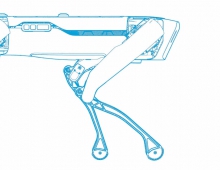
Tiny robot walks on water
With inspiration from nature and some help from research at the Massachusetts Institute of Technology, a team led by Carnegie Mellon engineering professor Metin Sitti built a tiny robot that can walk on water, much like the insects known as water skimmers or Jesus bugs.
It's only a prototype, but some researchers imagine the water-skimming robot could have many uses. With a chemical sensor, it could monitor water supplies for toxins; with a camera it could be a spy or an explorer; with a net or a boom, it could skim contaminants off the top of water.
Producing it was "the final challenge of microrobotics," said Professor Sitti, who runs Carnegie Mellon's NanoRobotics Lab. "It needs to be so light and so compact."
The robot is little more than a 13mm boxy body made from carbon fibre and eight 5cm steel-wire legs coated with a water-repelling plastic (technically making it a water spider).
It doesn't have a brain, any sensors or a battery. Its "muscles" are three flat-plate piezoelectric actuators - pieces of metal that bend when electricity runs through them. Wires run from the actuators to a power supply.
The robot can stand on water - it doesn't float - and can skim backward and forward, propelling itself with two legs that act like oars. Professor Sitti said he could build a more complex water-skimming robot within six months.
The prototype is especially impressive given researchers didn't know how water skimmers walked on water until last year.
Massachusetts Institute of Technology mathematician John Bush and two graduate students solved the riddle by placing dyes and particles in water and using a high-speed video camera.
The MIT team discovered that water striders move by pushing down on the surface of water with enough force to create valleys, but not enough to break the surface. The water then bounces back like a trampoline to push the insect forward.
Professor Sitti's prototype shows how important lighter and stronger materials have been to robotics.
"If you had asked us 10 years ago to build a water bug, I don't think we would have done it," said Mark Cutkosky, an Stanford University engineering professor who has been building roach-like robots.
Professor Sitti's robot weighs about a gram and so far, it's also cheap. He estimates the materials in his spartan prototype cost about $US10 ($14.40).
From AustralianIT





















